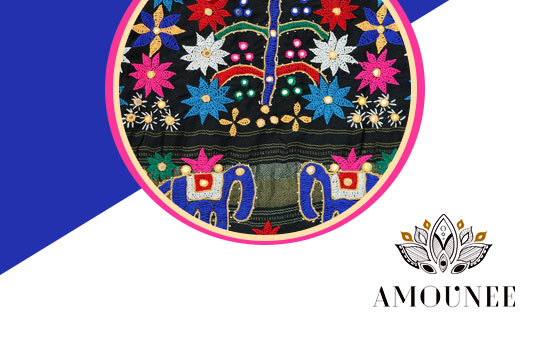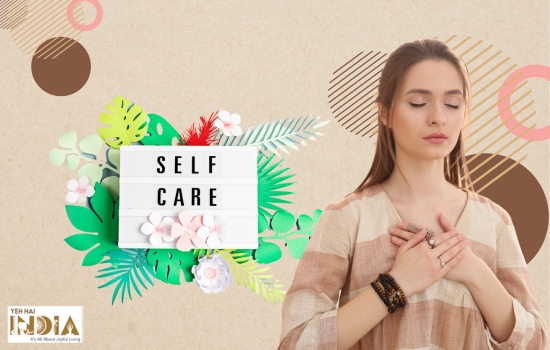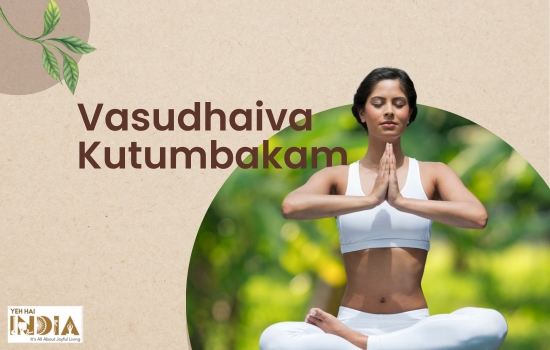Holistic Medicine— is said to be the art and science of healing which considers the whole person- body, mind, and spirit.
Holistic Medicine is an amalgamation of both conventional and alternative therapies to prevent and treat the disease. Along with that, it promotes optimal health.
People who have imbalances (physical, emotional or spiritual) in their lives are afflicted by health issues.
Holistic healing believes the natural forces within us are the true healers of disease as they help in balancing our life.
Recommended Story – Naturopathy- 10 Natural ways to heal your body
Principles of Holistic Medicine :

Following are the 10 principles of Holistic Medicine –
- Optimal Health: Helping people attain optimal health is the primary goal of holistic medicine.
- The Healing Power of Love : Holistic medical practitioners believe in meeting their patients with grace, kindness and acceptance, for they believe unconditional love and support can work miracles in the healing process of a person.
- Whole Person: Holistic medical practitioners treat the person as a whole. This includes taking into consideration the physical, mental, and spiritual aspects of the person.
- Prevention and Treatment: Holistic medical practitioners believe in promoting health, prevent illness and help raise awareness of diseases in people’s lives rather than only alleviating their symptoms.
- Innate Healing Power: It is seen that all of us human beings possess innate powers of healing in our bodies, minds and spirits. Holistic medical health practitioners evoke and help people suffering from diseases utilize these powers to enhance their healing process.
- Integration of Healing Systems : Holistic medical practitioners have integrated several, safe medical systems to treat their patients
- Relationship-centred Care: A good healing process in a patient depends mainly on the quality of the practitioner-patient relationship.
- Individuality: Holistic medical practitioners focus on patient care based on the patient’s individual needs and symptoms.
- Teaching by Example: These holistic medical practitioners incorporate the rules of holistic healthcare in their own life. This helps them gain a rapport with their patients and patients tend to follow their example for a good healing process.
- Learning Opportunities: Both patients and practitioners learn through life experience which includes birth, joys, suffering and dying.
Types of Treatments:

The treatments of holistic medicine have been divided into 5 categories. They are –
- Alternative Medical Systems– Several comprehensive healing practices developed thousands of years ago outside Western medicine, like Traditional Chinese Medicine (TCM), Ayurveda in India. The Alternative Medical system includes practices developed in the (late 18th to early 20th centuries), which includes Homeopathy & Naturopathy.
- Mind-Body Interventions- These include behavioral, psychological, social, and spiritual approaches. This ranges from yoga, meditation, cancer support groups to relaxation classes. The aim of this practice is to boost mental ability and increase physical health.
- Biologically-Based Therapies- This therapy uses plants or other biological materials. Examples of this are Aromatherapy, Herbal medicine, and Dietary supplements.
- Manipulative and Body-Based Methods- This practice involves manipulation, touch, or movement of the physical body. It includes Massage Therapy and Chiropractic
- Energy Therapies- This therapy believes energy fields that exist within and around a person’s body can be manipulated in order to improve health and well-being. This therapy requires some form of energy to heal like electromagnetic, thermal, ultrasonic etc. It includes reiki, healing touch & qi gong.
1. Alternative Medical Systems
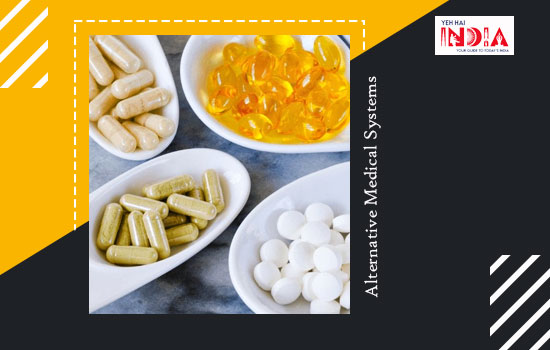
Traditional Chinese Medicine (TCM) –
Traditional Chinese medicine (TCM) evolved several thousands of years back in China. TCM practitioners use both mind and body practices to treat patients, these include Acupuncture, Tai Chi, herbs, diet, cupping, and qigong.
They believe in achieving good health and well-being by bringing about harmony in our lives. They believe harmony brings health, well-being, and sustainability in life while disharmony leads to illness and disease.
Acupuncture –
Acupuncture is a technique in which the TCM practitioners stimulate specific points on the body, by inserting thin needles through the body.
This stimulates the central nervous system which then releases chemicals into the muscles, spinal cord, and brain.
It is said these biochemical changes stimulate the body’s natural healing abilities and promote physical and emotional well-being.
Tai Chi– This practice is used for stress reduction and a variety of other health conditions. Tai chi helps people attain tranquillity through gentle, flowing movements.
Ayurveda –
Ayurvedic Medicine- It is mainly a holistic form of medicine. Ayurveda is considered to be the world’s oldest healthcare system.
It was founded upon the belief that all areas of life impact the health of a person. This practice strives to create harmony between the body, mind, and spirit, which they believe helps in preventing illness, treating acute conditions, thus contributing to a long and healthy life.
Homoeopathy –
It is a holistic method of treatment that believes that the body can cure itself.
Homoeopathic practitioners use tiny amounts of natural substances like plants and minerals to cure people. They are of the belief that these stimulate the healing process.
Naturopathy –
It is a system of holistic medicine that uses natural remedies to help the body heal itself.
Recommended Story – Floatation Therapy: Its Wonders
2. Mind-Body Interventions
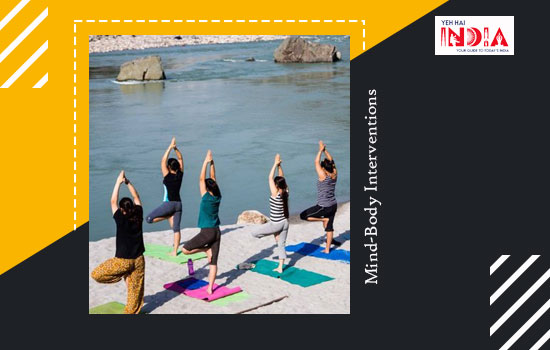
Mind-body practices or therapies are techniques that are designed to increase the mind’s positive impact on the body.
These techniques include behavioral, psychological, social, expressive, and spiritual approaches.
Meditation –
Mindfulness Meditation– It is the technique of bringing one’s attention to one’s breathing in order to connect with one’s present moment. This technique helps in decreasing stress and pain in people suffering from health issues, such as cancer. It even helps in keeping people calm in everyday life. Meditation improves sleep, memory, and attention span. It can be done at home, at any time.
Yoga–
Yoga is said to be a form of relaxation through movement.
- It involves calming the mind and focusing on one’s breathing while performing the yogic poses.
- Yoga helps in reducing stress and anxiety, enhancing mood, improving balance, flexibility and strength
- It is perfect for people of all ages to help enhance their fitness levels.
3. Biologically Based Therapies

Aromatherapy: It is referred to as the therapeutic application of plant essential oils ( these are naturally extracted plant materials) to balance, harmonize, and promote the health and healing of one’s body and mind. They help in-
- Relieving stress
- Fighting depression
- Improving memory
- Increasing energy
- Speed healing
- Easing headaches
Herbal Medicine: Plants are used in a medicinal form to treat diseases and enhance the health and well being of the patient. The aim of Herbal Medicine is to return the body to a state of natural balance so that it can self heal. Herbal Medicine shouldn’t be taken by oneself. It helps in increasing immunity and fighting infections.
Dietary Supplements: They are the substances that one takes to improve one’s health or wellness.
This includes vitamins, minerals, and herbs. The most common form is a pill or a capsule. One can even get them in the form of powders, drinks, and foods.
4. Manipulative and Body-Based Methods

Massage Therapy: Massage is an ancient therapy also known as manual manipulation of soft body tissues. This therapy involves stroking, kneading and pressing the soft tissues of the body to enhance health and well-being. There are several kinds of massages – ranging from soft and gentle to vigorous and brisk.
Massage helps in:
- De-stressing
- Alleviating pain
- Increasing athletic performance
- Helps in the overall well being of a person
- Lessens pain, reduces stress and anxiety in cancer-stricken people
It is useful in treating people with chronic issues.
Chiropractic– This is a kind of healthcare that focuses primarily on the diagnosis, prevention, and treatment of musculoskeletal disorders, which mostly involves the spine.
The word “chiropractic” comes from the Greek words cheir (meaning ‘hand’) and praktos (meaning ‘done’), i.e. Done by Hand.
This name was chosen by the developer of Chiropractic – Daniel David Palmer. Chiropractic uses only a holistic form of treatment, sans medications or surgeries.
Chiropractors or Chiropractic physicians are the doctors who perform chiropractic therapy.
They perform adjustments or manipulations to the spine or other parts of the body. This therapy mainly focuses on the relationship between the spine and the body’s function.
Benefits of Chiropractic –
- Correcting alignment problems
- Easing pain
- Improves muscle strength
- Supporting the body’s natural ability to heal itself
The Chiropractor should be well versed as this therapy carries the risk of injury if not performed properly.
5. Energy Therapies –
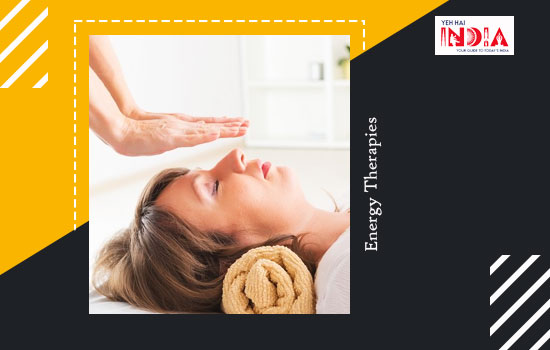
Healing Touch Therapy – It is a kind of energy therapy in which practitioners use gentle hand techniques which are thought to help re-pattern the patient’s energy field and enhance healing of the body, mind, and spirit.
This is based on a heart-centered and caring relationship in which the practitioner and client come together energetically to restore harmony in the patient’s energy system for good health and well being.
Benefits-
- Non-invasive
- Effective
- Non-Toxic
- Economical
Reiki- This is a form of alternative therapy which is also called energy healing, palm healing or hands-on healing. In this, there is a transfer of universal energy from the practitioner’s palms to their patient.
Benefits–
- Relaxation
- Helps in emotional, mental, and spiritual well-being.
Holistic is the new medicine!
Also Read – What is Past Life Regression Therapy and Top Practitioners in India





